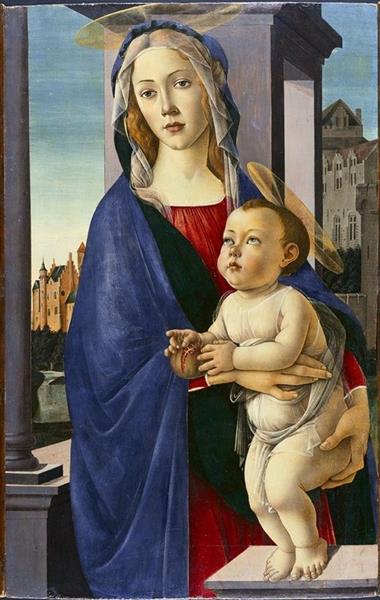Description
The work "The Virgin and the Child" by Sandro Botticelli, made in 1490, is a moving representation of motherhood and divinity, which encapsulates the essence of the Italian rebirth. Botticelli, whose artistic language is unmistakable, uses this painting to explore the relationship between the human and the divine, a recurring theme in his work. The image presents the Virgin Mary holding her son, Jesus, in a gesture of intimacy and tenderness that invites the viewer to contemplate not only the maternal relationship, but also the purity and devotion implicit in them.
The composition of the work is remarkable for its symmetry and balance. The Virgin is in the center of the painting, which establishes its central role in the scene. The soft lines that mark his figure contrast with the greatest visual energy of the Child Jesus, who seems to be in a moment of play, suggesting a vitality inherent in his divinity. The child's position, in particular, highlights a sense of movement, which adds dynamism to the composition, despite the serenity of the background.
The use of color in "the Virgin and the Child" is another aspect that stands out in the work. The palette used by Botticelli is soft and nuanced, predominantly the blue, red and gold. These colors not only provide aesthetic beauty, but also permeate the scene of a sense of sacredness and reverence. The blue of the Virgin's robe, traditionally associated with purity and heavenly, subtly contrasts with the warm tones of the skin of both characters, suggesting an intimate connection between the human and the divine.
Botticelli, known for his ability to represent the human figure ethereal, manages to capture an expression of serenity in Maria's face, which emanates a maternal calm. The Child Jesus, meanwhile, reflects a playful innocence, capturing the essence of childhood. These subtle gestures and expressions are characteristic of Botticelli's style, which often focuses on the aesthetics of idealism and beauty.
Although "the Virgin and the Child" is a representative work of sacred art, it also reflects the cultural context of the Renaissance, a period in which religion and humanism sought a balance. Botticelli, through its distinctive style, immerses itself in this duality, creating a space where the divine is experienced through the human. The influence of Neoplatonism, which emphasizes spirituality and beauty, can be felt in the way the Virgin is portrayed almost as an ideal of classical beauty, merging elements of Christian devotion with the aesthetic principles of classical antiquity.
Although "the Virgin and the Child" may not have the same notoriety as other masterpieces of Botticelli, such as "the birth of Venus" or "spring", its value lies in its introspection and the masterful integration of elements formal and symbolic. This work is not only a testimony of its technical ability, but also a deep reflection on the nature of maternal love and the relationship between humanity and the divine, aspects that continue to resonate throughout the centuries. "The Virgin and the Child" is, in its nucleus, a work that invites contemplation and astonishment, characteristics that make Botticelli a master unrepeatable of Renaissance art.
KUADROS ©, a famous paint on your wall.
Hand-made oil painting reproductions, with the quality of professional artists and the distinctive seal of KUADROS ©.
Reproduction service paintings With a guarantee of satisfaction. If you are not completely satisfied with the replica of your painting, we refund your money 100%.

